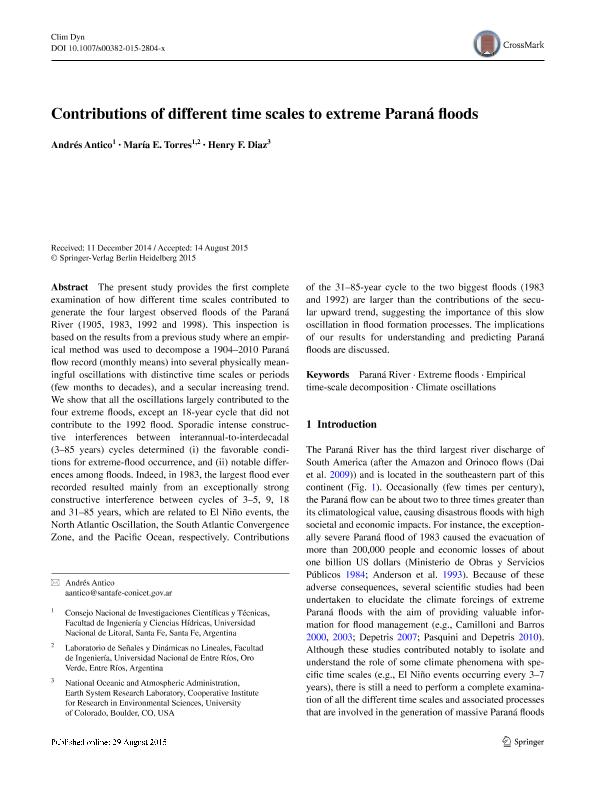Artículo
Contributions of different time scales to extreme Paraná floods
Fecha de publicación:
06/2015
Editorial:
Springer
Revista:
Climate Dynamics
ISSN:
0930-7575
Idioma:
Inglés
Tipo de recurso:
Artículo publicado
Clasificación temática:
Resumen
The present study provides the first complete examination of how different time scales contributed to generate the four largest observed floods of the Paraná River (1905, 1983, 1992 and 1998). This inspection is based on the results from a previous study where an empirical method was used to decompose a 1904-2010 Paraná flow record (monthly means) into several physically meaningful oscillations with distinctive time scales or periods (few months to decades), and a secular increasing trend. We show that all the oscillations largely contributed to the four extreme floods, except an 18-year cycle that did not contribute to the 1992 flood. Sporadic intense constructive interferences between interannual-to-interdecadal (3-85 years) cycles determined (i) the favorable conditions for extreme-flood occurrence, and (ii) notable differences among floods. Indeed, in 1983, the largest flood ever recorded resulted mainly from an exceptionally strong constructive interference between cycles of 3-5, 9, 18 and 31-85 years, which are related to El Niño events, the North Atlantic Oscillation, the South Atlantic Convergence Zone, and the Pacific Ocean, respectively. Contributions of the 31-85-year cycle to the two biggest floods (1983 and 1992) are larger than the contributions of the secular upward trend, suggesting the importance of this slow oscillation in flood formation processes. The implications of our results for understanding and predicting Paraná floods are discussed.
Archivos asociados
Licencia
Identificadores
Colecciones
Articulos(CCT - SANTA FE)
Articulos de CTRO.CIENTIFICO TECNOL.CONICET - SANTA FE
Articulos de CTRO.CIENTIFICO TECNOL.CONICET - SANTA FE
Citación
Antico, Andres; Torres, Maria Eugenia; Diaz, Henry F.; Contributions of different time scales to extreme Paraná floods; Springer; Climate Dynamics; 46; 11-12; 6-2015; 3785-3792
Compartir
Altmétricas




